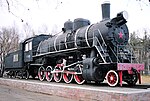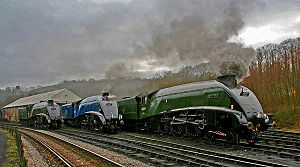Portal:Trains
Portals → Technology → Transport → Trains
The trains portal
|
In rail transport, a train is a vehicle or (more frequently) a string of vehicles capable of being moved along a continuous line of rails or other guideway for the purpose of conveying freight or passengers between points on a predetermined route. The train may be hauled or propelled by one or more vehicles designed exclusively for that purpose (locomotives) or may be driven by a number of motors incorporated in all or several of the vehicles (multiple units). As of 2018[update], there are approximately 1,052,000 kilometres (654,000 mi) of railway track in use worldwide. (World Bank (via Archive.org)) |
|
Selected article of the week
Under the Whyte notation for the classification of steam locomotives, a 2-10-0 is a locomotive with two leading wheels, generally in a radially swinging leading truck, and ten coupled driving wheels, five on each side. This arrangement was often named Decapod, especially in the United States, although this name was sometimes applied to locomotives of 0-10-0 "Ten-Coupled" arrangement. These locomotives were popular in Europe, particularly in Germany, and in Russia; British use of the type was confined to the period during and after World War II. In the United States, the 2-10-0 was not as popular but was a favorite of a small number of railroads, mostly in mountainous terrain. The 2-10-0's main advantage was that five out of six of its axles were powered, meaning almost all the weight was available for traction rather than being distributed over pilot and trailing wheels. The long rigid wheelbase caused problems on tightly curved track, so blind drivers were used on the central axle and sometimes on the second and/or fourth axles. Often lateral motion devices were attached to the leading drive axle. This wheel arrangement's disadvantages included the firebox size restriction caused by the lack of trailing wheels. The type operated as freight engine, although locomotives in Germany and the United Kingdom proved capable of hauling passenger trains.
Recently selected: Timetoget - 2009 Washington Metro train collision - Cargolink
Selected image of the week
A rare gathering of three ex-LNER A4 locomotives at Grosmont, North Yorkshire Moors Railway, during the LNER Gala on April 4, 2008. Reminiscent of the 'Top Shed' scene of the 1950s, 60009 Union of South Africa, 60007 Sir Nigel Gresley, and 60019 Bittern line up alonsgide each other at 7:30am, as they are prepared for service.
Recently selected: Dispatcher's desk - Installing rail in Uruguay - Rigi-bahn
Did you know...
- ...that the opening ceremonies of the Galway to Clifden railway were very sparsely attended because the event date was a strict church holiday and was reserved for attending church services?
- ...that following heavy damage to the Galveston Island Trolley track and cars from Hurricane Ike in 2008, substitute service with replica buses was operated until service resumed in October 2021?
- ...that although the former Santa Fe Railway's Galesburg station was demolished after regular passenger service to the station ended in 1996, the site is still used if derailments cause trains to use the Chillicothe Subdivision instead of the Mendota Subdivision?
- ...that the Fuzhou–Xiamen railway, which opened in 2010, was so heavily used that it reached capacity in 2015, spurring construction on the parallel Fuzhou–Xiamen high-speed railway for CRH passenger train services?
Selected anniversaries
- November 25
- 1835 – Andrew Carnegie, steel magnate and owner of Pittsburgh Locomotive and Car Works, is born (d. 1919).
- 1889 – The Toledo, Ann Arbor and North Michigan Railroad (predecessor of the Ann Arbor Railroad; map shown) begins operations between Frankfort, Michigan, and Toledo, Ohio.
- 1889 – Construction is completed on the Frankfort and South Eatern Railroad 3 ft (914 mm) narrow gauge line between Frankfort and Beecher, Michigan.
- 1971 – The Waltham North through South Sudbury stations on the Central Massachusetts Railroad are closed.
Train News
- July 24, 2021 – Atchison, Topeka and Santa Fe No. 2926, a 4-8-4 steam locomotive built by Baldwin Locomotive Works in 1944, moves under its own power for the first time since Christmas Eve of 1953, after nearly twenty-two years of being rebuilt by volunteers. The locomotive will be put into mainline excursion service. (NMSL&RHS, Trains Magazine on Facebook)
- May 5, 2021 – Steamtown National Historic Site completes thorough cosmetic overhaul on Union Pacific 4-8-8-4 Big Boy No. 4012, which is moved back on static display before National Train Day. (NEPA Scene)
- April 2, 2021 – 2021 Hualien train derailment – A Taroko Express train operated by the Taiwan Railways Administration (TRA) derails at the north entrance of Qingshui Tunnel in Heren Section, Xiulin Township, Hualien County, Taiwan, killing 49 people and injuring at least 200 others. North of Hualien City a construction truck had fallen down a slope onto the tracks. The eight-carriage train derailed after colliding with the truck, and then came to a rest in the tunnel, with severe damage and many casualties. (Bloomberg, CNN, CNA, New York Times, Financial Times)
- December 31, 2020 – Following a complete restoration, Chesapeake and Ohio 1309, a 2-6-6-2 Mallet locomotive built by Baldwin Locomotive Works in 1949, the last steam locomotive built by Baldwin for the North American market, is operated under its own power for test runs. When returned to service on the Western Maryland Scenic Railroad, it will be the largest steam locomotive in regular scheduled service in the United States and take 2-8-0 No. 734’s place as the largest active steam locomotive in the state of Maryland. (Trains.com Newswire)
- September 28, 2020 – Amtrak operates a test run using one of the 28 new Avelia Liberty trains manufactured by Alstom along the full length of the Northeast Corridor to Boston South Station. Previous test runs had occurred from Washington, D.C., only as far north as New Jersey and Delaware. Barring any problems, the trains are expected to enter regular service on the route in 2021. (Universal Hub)
- June 13, 2020 – The Bay Area Rapid Transit Silicon Valley BART extension opened its stations in Milpitas and North San Jose. (San Jose Spotlight, SF Gate)
General images
WikiProjects
WikiProject Trains (Shortcut: WP:TWP)
- WikiProject Stations (WP:STA)
- WikiProject Streetcars (WP:TRAM)
- WikiProject Rapid transit (WP:RTPJ) inactive
- By region:
- WikiProject Metros of the former Soviet Union (WP:SOVMETRO) inactive
- WikiProject Indian railways (WP:INRW)
- WikiProject Trains in Japan (WP:TJ)
- WikiProject New Zealand Railways (WP:NZR)
- WikiProject Pakistan Railways (WP:PKR) inactive
- United Kingdom
- United States
- Fictional rail transport topics:
Note: WikiProjects marked as inactive are retained pending future editing activity
Subcategories
Things you can do
See also Wikipedia:WikiProject Trains/Todo and Wikipedia:Pages needing attention/Railroads
Associated Wikimedia
The following Wikimedia Foundation sister projects provide more on this subject:
-
Commons
Free media repository -
Wikibooks
Free textbooks and manuals -
Wikidata
Free knowledge base -
Wikinews
Free-content news -
Wikiquote
Collection of quotations -
Wikisource
Free-content library -
Wikiversity
Free learning tools -
Wiktionary
Dictionary and thesaurus




















































































